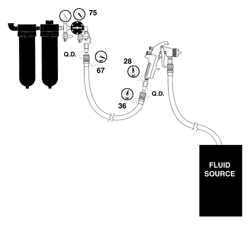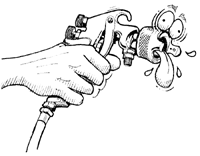Quality Finishing: Don’t Starve Your Spray Gun for Air!
Tips to Avoid Pressure Drop in Air Spraying
The flawless finish you set out to achieve is now an orange peel disaster. What went wrong? Pressure (psi) drop and lack of volume (cfm) are two of the many causes of imperfections in the finishing process. The air pressure that starts out as a shout at the air source is barely a whisper by the time it enters the spray gun, usually resulting in a poor finish. Too often, only atomization pressure requirements are considered when both pressure and volume are critical to the proper operation of a spray gun.
What Causes Pressure Drop?
The following factors contribute to pressure drop in conventional air spray and HVLP (High Volume Low Pressure) systems. Just one weak point may cause a major loss of pressure.
• Air hose that is too small in diameter
• Air hose that is longer than required or necessary
• Too many quick disconnect fittings in the system
•Restrictive quick disconnect designs
•Low performance air
regulators
•Inadequate capacity air compressors
Featured Content
Quick Air Connectors (Quick Disconnects or QD’s)
These devices are convenient, but depending on design, can be a major source of pressure drop. Ask yourself, does the application require them? If the air hose is not removed from the gun more than once or twice per day, these devices should probably be avoided. Consider the following:
Figure 1 shows areas where pressure loss can occur in a system. A beginning pressure of 75 psi from the air filter and regulator unit is reduced to 67 psi after going through a typical quick disconnect. Traveling through 25 ft of 1/4 inch hose at 25 cfm, air pressure drops to 36 psi before going through another quick disconnect. It drops again to 28 psi at the point it enters the spray gun after going through another quick disconnect.
“Quick disconnect” fittings are part of the sample system in Figure 1. It may be convenient to have a number of quick disconnects throughout a system for quick, easy detachment of hoses. But, even the best quick disconnect on the market will result in some pressure loss. With three or four quick disconnects, it’s possible to choke off the air supply almost entirely. Quick disconnects should only be used where necessary. A quick disconnect at the wall may only be used once a week, a steep price to pay for the loss of pressure.
In addition, all quick disconnects aren’t the same. Depending on the pressure and volume requirements, it is possible to have a pressure drop as little as 1 psi or as great as 25 psi for one quick disconnect. Examine the small opening in the female portion of the QD. The size of this opening is a good indicator of just how much potential restriction the QD may put on the air being supplied to the gun. For example, an opening of 0.305 inch would provide an area 2.4 times the area of an opening of opening in the female portion of the QD. The size of this opening is a good indicator of just how much potential restriction the QD may put on the air being supplied to the gun. For example, an opening of 0.305 inch would provide an area 2.4 times the area of an opening of 0.196 inch. Use “high-flow” quick disconnects with the largest diameter practical.
Using the Right Air Hose
Selecting the proper hose diameter is an important step in maintaining air pressure. Perhaps the least understood of all spray system components, air hose diameter plays a significant role in proper spray gun operation.
|
TABLE 1: Air Hose Pressure Loss Data
|
||||||
| Flow rates at air cap * |
15 cfm (0.42 cmm)
|
18 cfm (0.51 cmm)
|
20 cfm (0.57 cmm)
|
25 cfm
(0.71 cmm) |
||
| Hose Diameter and Length |
||||||
| 1/4 inch × 20 ft (6.3 mm × 6 m) |
20 psi
(137 kPa) |
26 psi
(179 kPa) |
28 psi
(193 kPa) |
34 psi
(234 kPa) |
||
| 5/16 inch × 20 ft (7.9 mm × 6 m) |
7 psi
(48 kPa) |
10 psi
(68 kPa) |
12 psi
(82 kPa) |
20 psi
(137 kPa) |
||
| 3/8 inch × 20 ft (9.5 mm × 6 m) |
2.8 psi
(19 kPa) |
4 psi
(27 kPa) |
4.8 psi
(33 kPa) |
7 psi
(48 kPa) |
||
| * Inlet air pressures are 85 to 90 psi (586 kPa to 620 kPa). Air consumption in cubic feet per minute (cubic meters per minute) is determined by the air cap design. As the table shows, the greatest amount of pressure loss occurs when the demand for air is the highest. For example, with a 1/4 inch hose, 34 psi (234 kPa) of pressure is lost at a volume of 25 cfm (0.71 cmm). | ||||||
With a smaller and more restrictive passage, less air gets through the line. Using a 1/4 inch (6.3 mm) hose means less pressure at the gun than when using a 5/16 inch (7.9 mm) hose. A 5/16 inch (7.9 mm) hose delivers less pressure than a 3/8 inch (9.5 mm) hose. The smaller the inside diameter of the air hose, the less air pressure delivered to the gun. Table 1 illustrates the loss in pressure with different hose diameters at different flow rates. For instance, there is a loss of almost 2 psi per ft (45 kPa/m) with a 1/4 inch (6.3 mm) hose at 25 cfm (0.71 cmm), compared to a loss of less than 0.5 psi per ft (11 kPa/m) with the larger 3/8 inch (9.5 mm) hose at 25 cfm (0.71 cmm). Air hose with 1/4 inch inside diameter (ID) is not recommended for use with any air spray guns.
The “right diameter” does not mean that you have to use the biggest hose. Hose length is also a factor. As air is forced through the line, pressure decreases the farther the air has to travel. Use the best combination hose ID and length to prevent over-restricting the air supply.
Select a Quality, High Flow Air Regulator
Air regulator design can also restrict air flow and can create excessive pressure drop. Check the gauge on the regulator with both static (no flow) and dynamic (spray gun in use) conditions. If there is a pressure drop reading difference of more than 5 psi, the regulator may be too restrictive. Select an air regulator capable of flowing enough air for your spray gun. Regulator capacity specifications should exceed spray gun demand. In addition, using an air cap test kit (HVLP systems) to verify the air cap pressure setting can help ensure proper atomization quality and code compliance.
Select Quality, High Performance Air Compressors
Modern spray guns, particularly HVLP, require greater volumes of air to atomize today’s high solids coatings. Air compressors must be adequately sized to handle the volume and pressure requirements throughout the system. This is especially important considering the restrictions of quick disconnects, small diameter hose, other air tools, and other compressed air demands.
Special Considerations for HVLP Systems
Unlike conventional air spray guns, modern HVLP spray guns atomize coatings by using a high volume of air at low air cap pressure, generally in the 1 - 10 psi range. In a typical HVLP design, the regulated 50 psi (345 kPa) of air supplied to an HVLP spray gun will be reduced to a pressure of no more than 10 psi (68 kPa) as measured at the air cap. In a conventional air spray gun, air cap pressure is restricted only by compressor capacity, regulator pressure and normal pressure drop conditions. Under these conditions, conventional air cap pressure can be considerably higher.
HVLP spray depends on sufficient air pressure and volume at the air cap for optimum performance. All of the above sources of pressure loss can prevent enough air from getting to the spray gun to generate the necessary air cap pressure.
In general, avoid using 1/4 inch hose for all spray guns. With the volume requirements of HVLP spray guns, avoid using 5/16 inch hose to ensure maximum air available to the spray gun. Use quick disconnects only when the air hose must be removed from a gun several times per day. Choose QD design carefully to insure that the least restrictive units are used. Use one QD per gun located at the gun inlet.
Wall-mounted regulators typically have larger air passages than gun-mounted regulators. The larger air passages minimize pressure drop compared to the smaller gun-mounted regulators. These regulators provide a constant air pressure delivered to the gun. Air pressure controlled with an air-adjustment valve-type restrictor will first exit the air cap with an initial burst of pressure, then level off to the adjusted pressure and may fluctuate with changes in system pressure.
Air Cap Test Kits Pay Off
A final suggestion is to use an air cap test kit with HVLP spray guns. Using the test kit takes the guesswork out of analyzing the amount of air available. Knowing the amount of air pressure at the air cap allows you to determine whether there is enough air to atomize the material being sprayed and remain compliant with environmental regulations.
RELATED CONTENT
-
Is Your Electroplating Waste Hazardous?
Some that bears precious metals is, and there are a host of regulations to consider when recycling.
-
Coating Thickness Measurement: The Fundamentals
A review of available test methods, common applications and innovative instrumentation...
-
A Current Affair: Examining the "No Amperage" Phenomenon
If you are performing a coating process that requires the use of a rectifier, you may have experienced the "no amperage" problem. Here's a look at the phenomenon and some solutions…




















